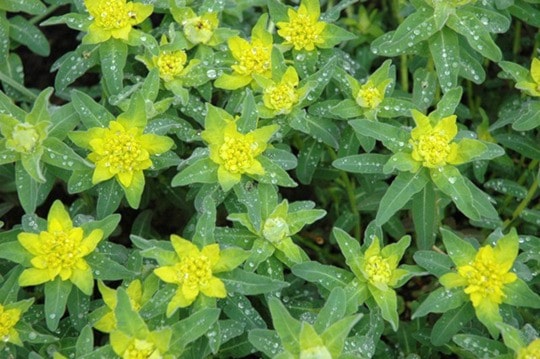One of the best kept secrets for lasting early colour is the amazing family of evergreen euphorbias. Hardy to zone 4 and 5, they are a perfect year round addition to our gardens. They will tolerate full sun but prefer partial shade and are quite comfortable even under trees. Many varieties are quite drought tolerant, making them ideal candidates for our now typically hot, dry summers.
As we move closer to spring, each evergreen stem bows its head and lifts its back up with the most amazing display. What we perceive to be flowers are actually coloured bracts with tiny inconspicuous flowers inside. From soft yellow to hot lime and golden bronze/green, the range and size of these bracts is quite remarkable. They last for weeks, even months, to create a brilliant display in our early spring gardens.
Because of their diverse size and form, evergreen euphorbias are ideally suited for use as ground covers and feature plants and are spectacular in containers and borders. In containers I love to combine euphorbias with other attractive foliage plants like evergreen grasses, heucheras, bergenias, dwarf conifers, broadleaved plants and winter flowering heather. Today, it’s all about foliage, and the colour blends we can create with euphorbias and their companions is quite amazing. These plants can stay in containers year round with only a little tweaking to make them more in tune with the current season.
The most spectacular bracts are found on the older variety E. characias wulfenii. Its blue foliage, topped with large chartreuse bracts that last for months, is truly stunning. It will grow up to four feet tall and four feet wide. It’s variegated cousin, E. c. ‘Tasmanian Tiger’, has created quite a stir in the plant world with its white and green foliage and bracts. It’s a ‘wow’ plant that lights up any garden. A new introduction, called ‘Glacier’, with its blue, green and white foliage is more subtle and yet very beautiful and makes a delightful accent plant. Another variegated euphorbia that has captured quite a bit of attention is ‘Helena’. It’s a very soft green, edged with white, that brings out some nice pink shades in the cooler weather of winter and early spring. It has vibrant chartreuse flowers.
Dark foliaged plants have become popular year round as accents, and the old fashioned E. amygdaloides ‘Purpurea’ turns the most spectacular deep burgundy in winter and still holds this colour as the chartreuse blooms open up for a brilliant contrast. The most recent introduction, E. ‘Bluebird’, not only has deep burgundy foliage in winter, but it also holds its colour well into summer.
There are more euphorbias available today than ever before, and each has its own unique characteristics and charm. Euphorbia robbiae, for example, performs wonderfully in heavy shade, producing great colour all year in spots where it’s hard to grow many plants. This is the time of year to visit garden centers to look at all the many different varieties and see how they can add so much evergreen beauty to your garden and containers.
